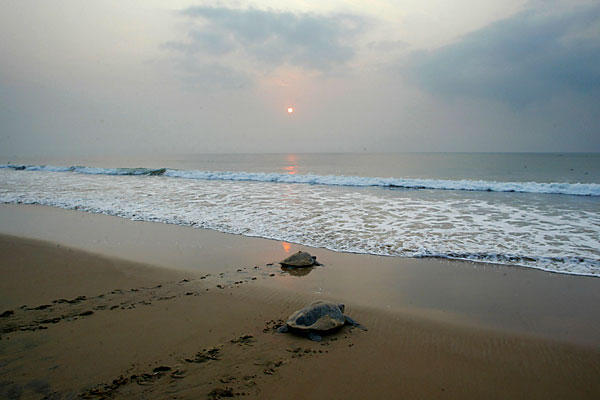Global Warming Resolves Island Dispute with Wisdom of Solomons
Greatest Story Summary Evah: “Rising sea levels have submerged an island claimed by both India and Bangladesh. Global warming appears to have buried the dispute.”
More details:
Turtles on the Gokhurkuda beach, return to the Bay of Bengal sea about 88 miles from Bhubaneshwar, India, March 18. Rising sea levels have submerged the island, Indians call New Moore island and the Bangladeshis call South Talpatti, which lies in the Bay of Bengal. Biswaranjan Rout/AP
What the Indians call New Moore island and the Bangladeshis call South Talpatti lies in the Bay of Bengal, a region with large potential reserves of gas and oil. Satellite imagery shows the island now submerged, says Sugata Hazra, director of the School of Oceanographic Studies at Jadavpur University in Calcutta.
“We can see the island still at lowest-tide level, and it has dispersed within the sea,” says Professor Hazra. “It is below the high-tide level.”
He blames the loss of the uninhabited island — and several others in recent years — to rising sea levels and surface temperatures in the northern Bay of Bengal. “Climate change is one of the major impacting factors,” he says, adding that “it may not be solely responsible.”
The islands in the area are the unstable creations of the Bhramaputra river delta. New Moore first emerged on satellite images in 1974, and in 1981 India sent naval ships to plant a flag. The island has become central to a broader maritime dispute intensifying as a United Nations deadline of 2011 looms for resolving the issue.
Given that the island has been above water for only 36 years and is home to no one, this is more amusing than anything else.




This story is a hoax.
Global Warming doesn’t exist, so it couldn’t have ‘sunk’ an island. Al Gore and East Anglia probably created this story in order to sell what the public doesn’t want.
If an island really did sink, it was probably because God wanted it to. It’s called Intelligent Pushing.
I would expect that one or more of the countries will be dumping landfill on the barely undersea former island, to raise it above sea level again, so they can claim sovereignty and mineral rights.
Not only was the sand bar of an island only created 36 years ago by a cyclone (hurricane), but it’s part of the Ganges river delta that has long been known to be subsiding.
An AP report is even more misleading. It begins: (my emphasis)
In essence, it’s a bunch of malarkey.
Climatologists did not blame the island’s appearance on Global Cooling and its consequent lowering of sea level, but they want to blame it’s disappearance on Global Warming and its consequent raising of sea level. Am I the only one here who detects a strong smell of mendacity?
The mere fact that an island is above the surface at high tide is not in and of itself sufficient to make a claim for full national territorial rights (for oil and gas ownership for example) under international law.